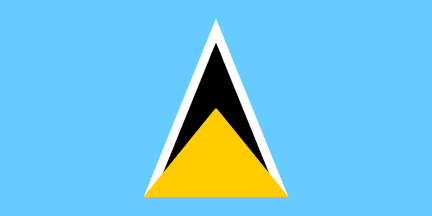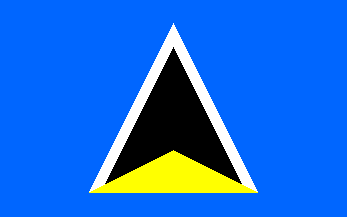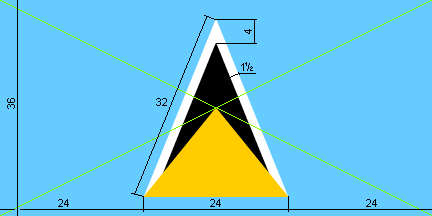 (1:2)
(1:2)
by Željko Heimer, 4 January 2003

Last modified: 2005-05-28 by dov gutterman
Keywords: saint lucia | beach | volcano | america | santa lucia | st. lucia |
Links: FOTW homepage |
search |
disclaimer and copyright |
write us |
mirrors
 (1:2)
(1:2)
by Željko Heimer, 4 January 2003
Official Name: Saint Lucia
Capital: Castries
Location: Caribbean
Government Type: Constitutional Monarchy (Queen
Elizabeth II)
Flag adopted: 22
February 1979
Designer: Dunstan St Omer
Coat of arms adopted: 1 March 1967
ISO Code: LC
See also:
At <www.stlucia.gov.lc>
is the official flag of Saint Lucia. The colours has been changed
in the last time, because at sites before November last year the
colours was as known (dark blue and yellow). Did anybody knows
when the colours was officially changed (22.02.2002(?)) ? "
Falko Schmidt, 15 April 2002
Did you notice that in the quoted website the flag behind the
photo of St Lucia Prime Minister is still dark blue ?
Armand Noel du Payrat, 17 April 2002
Note that the present PM is in office since 1997 so that his
photo maight be quite old. It's interesting that both image and
description are compatible - they both describe the flag as
"cerulean".
Jan Zrzavy, 17 April 2002
The most intriguing fact is that the flag description says
cerulean (sky) blue since its design, but has always been render
a darker blue. I have been in St. Lucia, but many years ago, and
it was a darker blue then.
Blas Delgado Ortiz, 17 April 2002
The light blue flag is a new flag. Confirmed by the UN office
of St. Lucia, who wrote me that the flag was adopted after their
website had been completed, and so they show the old design in
dark blue. The adoption date lies between December 2001 and March
2002. The office promised me complete infos.
Ralf Stelter, 13 May 2002
The web mentions that the flag was designed by Dunstan
St.Omer. I believe he is a designer of the first national
flag.
Nozomi Kariyasu, 31 May 2002
St. Lucia is probably returning to the original flag colors.
Some older sources, at least the Czech vexillological book
written by Ludvik Mucha, did show the light blue flags in 1970's
and early 1980's. I think that the color change took part in
about 1979, together with changes of the flag geometry.
Jan Zrzavy, 1 June 2002
In use since 1 March 1967, officially adopted 22 February
1979. Used as civil, state and war flag and ensign. Proportions
1:2.
Mark Sensen, 29 January 1996 and Željko Heimer, 13
March 1997
St. Lucia was first settled by France in 1650. During French
rule, it used the same flag as Martinique, its neighbouring
island to the north. It became British in 1814 - so the first
ensign could date at least to this time. Afterwards, the two
rulers were changed several times, but it finally remained a
British dependency into the 'modern era'. In 1939 the arms were
granted. Internal self-government was granted in 1967 (when it
became an Associated State of Great Britain). Full independence
in 1979.
Željko Heimer, 18 March 1997
The flag represents the island surrounded by the sea - two
triangular shapes on the flag represent two volcanic hills, the
Pitons, which are recognized by the people of St. Lucia and by
the world as the symbol of this island. Please refer here, for an
illustrative photo of the Pitons.
Joseph Sexton, 14 August 1998
From Dorling-Kindersley Pocket Book [udk97]:
"It [the flag] was designed by a local artist, Dunstan St
Omer. The blue field represents the sea, from which arise the
twin peaks of the Pitons said to be 'rising sheer out of the sea
and looking skyward - a symbol of hope'. The yellow triangle
stands for sunshine and the black arrowhead on white, for the
twin cultures of the island. [...] A new form of the arms was
also adopted, symbolizing the national motto 'The Land, the
People, the Light'.Apart from the Governor-General's
flag and that of the capital Castries, no other flags are
known."
Ivan Sache, 31 January 2000
From <www.stlucia.gov.lc>:
Description:
Saint Lucian artist Dunstan St. Omer, designer of the National Flag, has described it as follows:
Dimensions of the National Flag
The dimensions of the National Flag shall be in the following proportions: 6'x3' and 9"x4.5"
Meaning of the Flag
Falko Schmidt, 15 April 2000
According to Album 2000 [pay00]
- National Flag (CSW/C-- 1:2) - The Album 2000 has medium blue
field, while corr. 2 has it much lighter, after the recent
reports.
Željko Heimer, 2 January 2003

by Željko Heimer, 18 March 1997
In use 1-MAR-1967 to 1979: same as current flag, but the
golden triangle was lower. The blue background was lighter than
today. Proportions about 5:8. Used as civil and state flag and
state ensign. Reference: [smi80].
Željko Heimer, 13 March 1997

by Željko Heimer, 4 January 2003
Flag adopted: 22 February 1979

by Željko Heimer, 4 January 2003
Corr. 2 to Album 2002 [pay02]
also include some basic construction details (i.e. flag length is
shown as 2+2+2, height 6; though exact measuring of the image
there proves that the image was not made according to the
numbers, the base of the triangle being some 30% longer then the
distances to the edges). Above we have quote from the government
site, quoting the flag designer, so we know that the width of the
visible white stripes is 1.5" and the distance between the
tops of the white and black triangles is 4", however we
don't know exactly on how big flag this is measured. But, I think
that we may safely assume that one of the two official sizes of
the flag might be a safe choice. The same site mentioned above
continues with flag description, but now not quoting the author
any more: "Dimensions of the National Flag The dimensions of
the National Flag shall be in the following proportions: 6'x3'
and 9"x4.5". We may safely assume that Dunstan talks
about the 3'x6' flag (i.e. 1x2m), and not about 4.5"x9"
(which is ca. 10x20cm, presumably the table flag. Apparently, now
the Dunstan's description is enough to construct the whole flag,
with few assumptions that I'll point out on the way.
Knowing the dimension 1.5" and 4" as described above
and knowing that the base of the triangles is 1/3 of the flag
length 2' = 24", it is fairly easy to show using basic
geometry that the length of the sides of the white isoscales
triangle are 32". If we interpret the description rightly,
the top of the yellow trangle is in the midpoint of the flag.
For those who like to know measures, even approximately along the
main axes, it is fairly simple to compute that the height of the
emblem is ca. 29.6". Rounding this to 30, one may easily
show the construction details as: (3~+30~+3~):(24+24+24) or
rationed as (1~+10~+1~):(8+8+8).
Admitedly, this produces the triangle somewhat taller that I am
used to see in vex-books, but it may well be so.
All this assuming that Dunstan is talking about 1:2 flag. As we
have shown, the original 1967 Flag might have
been 5:8~. However, the story about the flag ratio change, just
as the reports on the different blue shades sound quite fishy to
me, and while these may well be true reports of the flags seen in
use, it may well be that the official flag specification (if
there was one) was never changed since 1967 actually.
Željko Heimer, 4 January 2003
I have today received official specs for the flag of St Lucia
via Jos Poels, and the details are as follows:
"Notice.
Saint Lucia National Flag and Coat of Arms.
Due to concern over the various representations of the National
Flag on souvenir items and other memorabilia, and the need for
standardization of such items, permission should be sought from
the Office of the Prime Minister before the importation of all
souvenir items bearing the Coat of Arms and Flag of Saint Lucia.
This request is in accordance with Clause 15 of the Third
Schedule Part II (Restricted Imports) of the Customs (Control and
Management) Act No. 23 of 1990.
The official colours, proportions and dimensions of the Saint
Lucia National Flag are given as follows: Colours of the Saint
Lucia National Flag: Cerulean Blue (Process Cyan 100%), Light
Chrome Yellow, Black, White.
Proportions of the Saint Lucia National Flag: Width of the white
part of triangle - 1 ½ inches on both sides of the black;
Distance between peaks of black and white triangles - 4 inches;
Length of common base shared by triangles - 1/3 of the length of
the Flag.
Dimensions of Saint Lucia National Flag: Pole Flag - 6 feet x 3
feet; Hand Flag - 9 inches x 4 ½ inches; Desk Flag - 6 inches x
3 inches; Casket Flag - 11 feet x 5 ½ feet.
It is also recommended that the Coat of Arms, as the Official
Seal of Government, should not be reproduced for commercial use
or sale."
Source: Saint Lucia Nationwide, a publication of the
Department of Information Services, No. 29, Saturday 25 October
2003, p. 8.
I calculate (based on the above and a flag of 72 x 144 units)
that the white triangle has a height of 54 units and a width of
48 units, while the black triangle (allowing for a 3 unit border
at each side) has a height of 46 units and a width of 48, with
the white being centred on the flag. The height of the
yellow triangle is not officially specified, but I have put its
apex at the centre-point of the flag as being the logical place
for it to be.
The details are taken from Saint Lucia Nationwide, a publication
of the Department of Information Services, No. 29, Saturday 25
October 2003, p. 8. It was, however, issued in
accordance with Clause 15 of the Third Schedule Part II
(Restricted Imports) of the Customs (Control and Management) Act
No. 23 of 1990 (with no date or month given).
Christopher Southworth, 28 April and 4 May 2005
I took upon calculating the measures that Christopher
Southworth sent and I reached to exactly the same
conclusions as I gaveabove. Calculating trigonometly from what
dimensions are provided yeald the length of the edge of the white
triangle as 32". This again provided vertical division as
approximately 3+30+3, that is not like Christopher give!
(in Christopher measures "my trinagle" is
59.33 while his is 46+8=54).
That the side is 32 is easily shown using basic geometry: since
the rightangled triangles A aqnd B are similar; A of sides 1.5
and 4 and B of sides 12 and x, where x is the length of the
"white edge", x must be equal to 4*(12/1.5)=4*8=32.
Željko Heimer, 2 May 2005
"Chrome" can mean several different colours, but
usually refers to yellow. In this case, it would mean that the
yellow has a slightly amber tinge rather than being lemon yellow.
James Dignan, 3 May 2005
There is an anecdotal but exotic story involving the Caribbean
island of Saint-Lucia and the French national flag.
In the south of the island, there is a city called Choiseul,
whose history is the following:
"Many old maps of Saint Lucia show a place called Anse
Citron where you would expect to see Choiseul. In English that
means 'Lime Bay'. Perhaps the sailors who went ashore for food
and water found limes growing there. This would have been an
important discovery. Lime juice was a protection against scurvy,
a disease caused by being too long at sea without fresh fruits or
vegetables to eat. Until 1763, the village near the river mouth
was also called Anse Citron. In February of that year, the
English and the French signed a pact called the treaty of Paris.
It made Saint Lucia a French possession. They celebrated by
remaining the village Anse Choiseul in honor of the Duke of
Choiseul, French Minister for Foreign Affairs. This was later
shortened to 'Choiseul'. During the French Revolution, the
Republican General Richard was sent to govern Saint Lucia. He
gave all towns and villages new names. Choiseul was now called
'Le Tricolore', like the French flag with its bands of red, white
and blue. In 1796, the British defeated the French and Le
Tricolore became Choiseul once again." [Source:
<aboutstlucia.sluhoo.com>].
Choiseul (1719-1785) signed on 10 February 1763 the treaty of
Paris, by which France lost Canada, India and Louisiana (then
much bigger than the today's state fo Louisiana). During the
French Revolution, all emblems of the Ancient Regime, including
the administrative divisions and the coats-of-arms, were
suppressed. The most zelacious revolutionaries also changed the
place names which alluded to the Ancient Regime. Although
Choiseul had been fairly progressive, a good minister and close
to the Encyclopedists, his name could not remain attached to a
village, even in a very remote possession of the French Republic.
Ivan Sache, 26 Febuary 2004
Saint Lucia is divided to 8 regions. There are no known flags
of those regions. The regions are:
- Anse la Raye
- Babonneau
- Castries
- Dennery
- Gros Islet
- Saint Lucy
- Micuod
- Soufriere
- Vieux Fort
List based on Administrative
divisions of the World.
Dov Gutterman, 25 October 2004